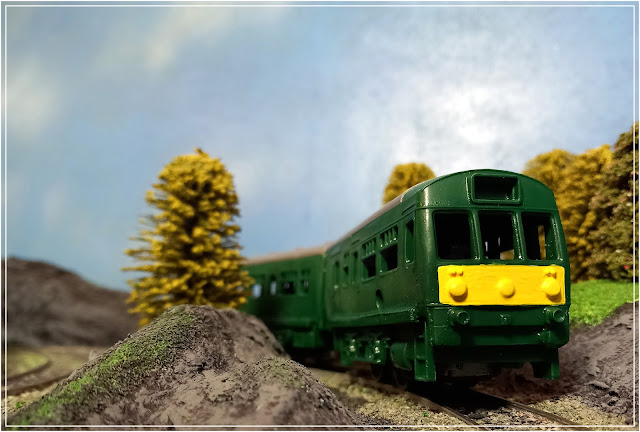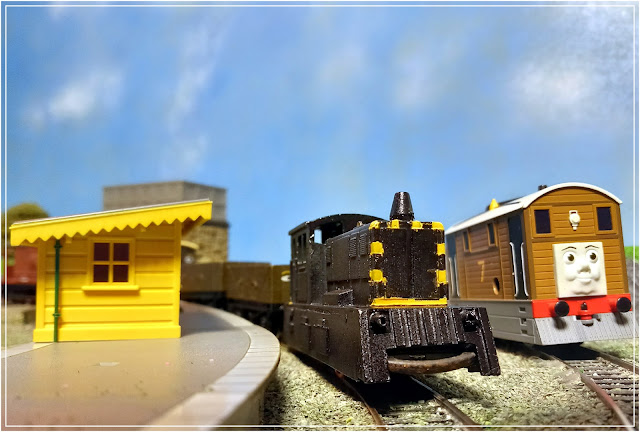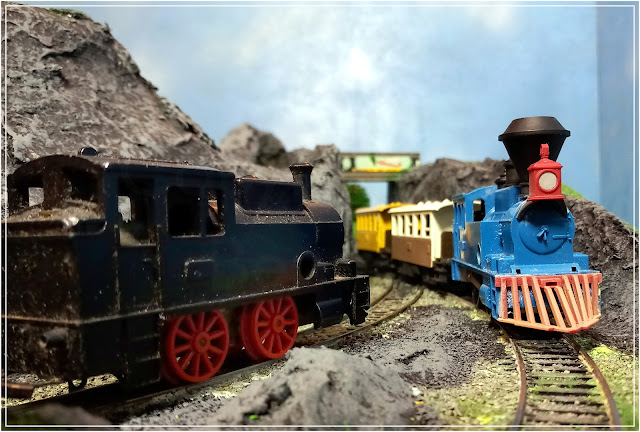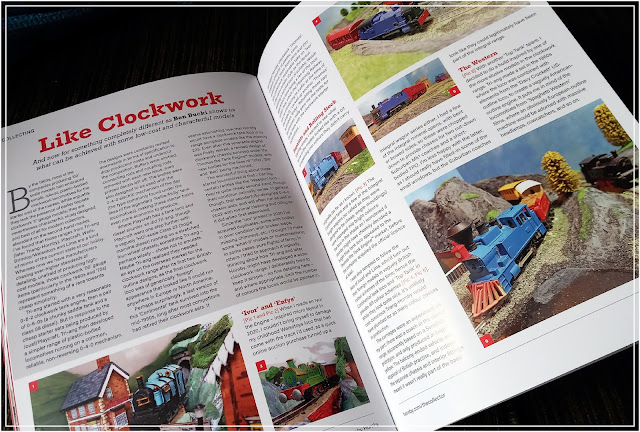A few years ago, after signing my (then) train-mad youngest to the Hornby Collectors Club, I made an enquiry to the editor about if he would be interested in an article or two. This has led to a very nice, regular gig writing for Hornby since, where The Collector seems happy to indulge in some of my slightly more bonkers projects... So (typically for this blog) I need to go back in time, to projects from a couple of years ago, whilst I play catch-up with half-a-dozen printed articles to put up here on the blog.
When Lockdown hit, I ended up doing a little Clockwork layout; I've written in more detail about this elsewhere, but sufficed to say, my personal mental retreat into a safer past saw me developing a fascination with collecting 00 gauge clockwork starter locomotives, the cheaper alternative to the world of vintage 0 gauge tinplate. Coupled (ha, train pun) with my long-standing love of the Ivor the Engine books and films, and producing a layout which was really more of an art project than a model railway.
It was fun to do, and I might end up blogging a bit more about it in due course, but it has led to plans for something similar but non-Ivor based to make later this year.
Of course, with time on my hands in 2020 and internet shopping as a tempting venue, I'd started collecting a lot of these trains. Back in the 1960's, and indeed up until the early 1990's, Hornby, Triang, Playcraft and a few other companies made these locomotives to tempt kids into the hobby. In the days before reliable small batteries, clockwork was the alternative, and these trains tend to be rather unloved and often very cheap online.
I bought a few job lots and old sets, trying to get hold of decent examples of each, ending up with a lot of broken or damaged ones in the process.
With the question of what to do with these tatty examples, I thought I'd start a little project of making some 'what-if' models (known as "Neverwazzas" in the modelling world, I gather). Looking at it logically, and planning for a never-made expanded range of 00 clockwork locomotives by Triang Hornby, later Hornby Railways.
The DMU
I love the Triang Met-Camm; I inherited one that was my Dad's when he was little, and can remember watching the real things on the level crossing at Langley Green when I was a child. As one of Triang's better early models, I wondered if I could do a clockwork version of it. An online purchase of a set of bodies from one of the later-generation Hornby examples from the 70's followed.
Seen above with a different roof; I'd gone cheap with trying to use another roof from a broken coach, and it didn't quite work. In the end a quick shop to an online 00 gauge parts dealer provided me with an original DMU roof.
Coughs and Sneasels? Making Dis-easels.
Triang and Playcraft each made a clockwork 4-wheeled diesel shunter, but generally the companies stuck to the nostalgia-magnets of the steam tank locomotive. I thought I'd try and make a few diesels, as a bit of a change.
I stuck with the ever-reliable 4-wheeled clockwork chassis by Hornby.
The body was one of the Hornby Dublo class 08 bodies (a few of the later Wrenn-produced versions are available online), cut-down and fitted onto a Hornby clockwork Thomas.
Length cut-down, glued, filler, sanding, and dusted with primer.
Two more shunters; a standard Triang North British 4-wheeler given tramway skirts from plasticard, and one with a rebuilt bonnet to look like like a YEC industrial shunter.
I chose to try and keep these simple (these were in reality budget starter toys, with as little money spent on them as possible), so not too many details, and simple two-colour paint jobs for most of them. I also ended up going cheap on the masking, and cut-down some standard masking tape when I should have purchased some better, thinner tape.
The Models
The only starter carriages in reality were some balcony-ended yellow examples, so I made some by using broken wagons and cut-down bodies from period Triang coaches; again, I wanted to try and approach these from a logical approach that Triang might have done at the time.
A standard shunter at the back, and a repainted version in front (no other modifications than the paint job and a BR logo).
The YEC shunter, in eye-catching colours. Really the stripes should have gone round to the ends, as per British Steel colours, but it was already taking a lot more effort to mask and paint than I had time for before the deadline.
The DMU.
The set for the photographs, btw, is Younger Child's 00 gauge layout, which has been gathering dust in the cupboard for a while. The backdrops are my standard ones I use for indoor shoots, with a borrowed studio lamp.
The 08 is probably my favourite of them all, and it looks like a model which could have actually existed.
The only thing I think it needs is better steps under the cab doors, maybe a modification to make in the future.
It's in black so it could be used for Diesel from Thomas, a logical way it could have survived in the range up to the 1980's.
The North British shunter with skirts, keeping with the Thomas the Tank theme, as a passable "Mavis".
With a clockwork 'Toby', one of the latter Hornby clockwork locomotives.
The clockwork 'Western' tank is probably the holy grail of the clockwork range and goes for big money second-hand. Unable to acquire one yet, I made my own by combining parts from the cheapo 'Toy Story' loco Hornby produced a few years back.
Posed with a standard, unmodified version of the same donor locomotive.
For some of the better-quality locomotives which I had duplicates of, I did some resprays in colours which I hadn't seen produced commercially.
And one slightly mad one, in my favourite livery, Railfreight Red-Stripe. The red loco alongside is one of the last-produced examples which were still in the catalogue in 1993.
It got a really good feature in "The Collector", the in-house mag of the Hornby Collectors Club.
I really enjoyed doing this- more so than some of the more 'serious' model making I've done in recent years. So much so, that I'm planning a little clockwork-only layout to run these on. It also led to a lot more Hornby articles, and I'll be posting about them in coming months as well.


































No comments:
Post a Comment